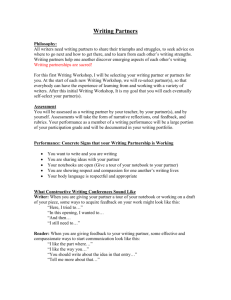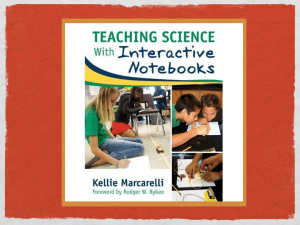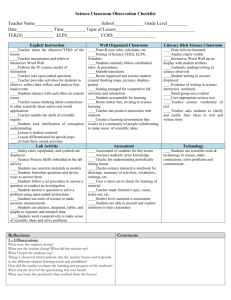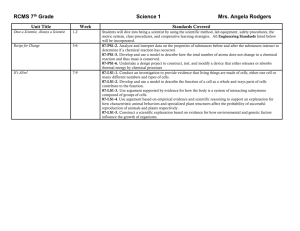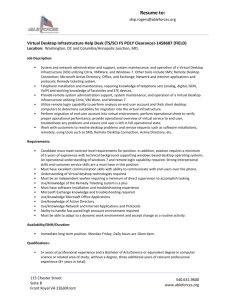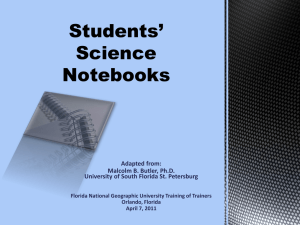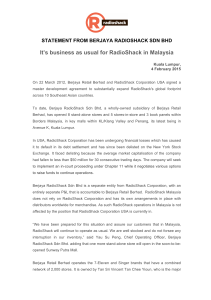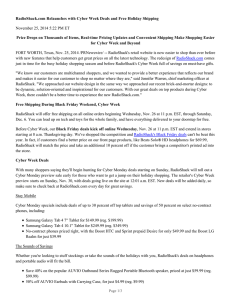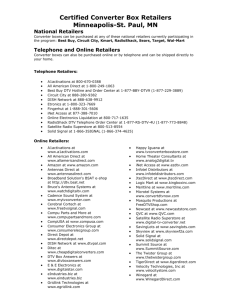2nd Grade 1st Six Weeks Suggested Pacing 2013-2014
advertisement
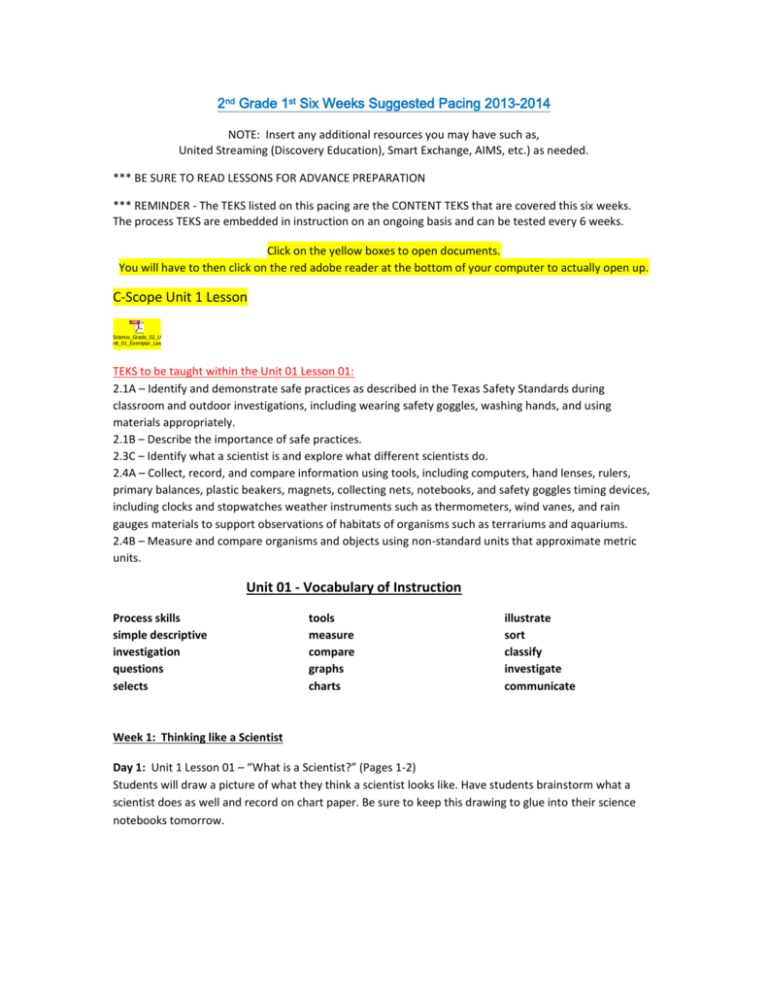
2nd Grade 1st Six Weeks Suggested Pacing 2013-2014 NOTE: Insert any additional resources you may have such as, United Streaming (Discovery Education), Smart Exchange, AIMS, etc.) as needed. *** BE SURE TO READ LESSONS FOR ADVANCE PREPARATION *** REMINDER - The TEKS listed on this pacing are the CONTENT TEKS that are covered this six weeks. The process TEKS are embedded in instruction on an ongoing basis and can be tested every 6 weeks. Click on the yellow boxes to open documents. You will have to then click on the red adobe reader at the bottom of your computer to actually open up. C-Scope Unit 1 Lesson Science_Grade_02_U nit_01_Exemplar_Lesson_01__Thinking_Like_a_Scientist.pdf TEKS to be taught within the Unit 01 Lesson 01: 2.1A – Identify and demonstrate safe practices as described in the Texas Safety Standards during classroom and outdoor investigations, including wearing safety goggles, washing hands, and using materials appropriately. 2.1B – Describe the importance of safe practices. 2.3C – Identify what a scientist is and explore what different scientists do. 2.4A – Collect, record, and compare information using tools, including computers, hand lenses, rulers, primary balances, plastic beakers, magnets, collecting nets, notebooks, and safety goggles timing devices, including clocks and stopwatches weather instruments such as thermometers, wind vanes, and rain gauges materials to support observations of habitats of organisms such as terrariums and aquariums. 2.4B – Measure and compare organisms and objects using non-standard units that approximate metric units. Unit 01 - Vocabulary of Instructionof Instruction Process skills simple descriptive investigation questions selects tools measure compare graphs charts illustrate sort classify investigate communicate Week 1: Thinking like a Scientist Day 1: Unit 1 Lesson 01 – “What is a Scientist?” (Pages 1-2) Students will draw a picture of what they think a scientist looks like. Have students brainstorm what a scientist does as well and record on chart paper. Be sure to keep this drawing to glue into their science notebooks tomorrow. Day 2: Unit 1 Lesson 01 - Explore (page 3-4) Students set up their Science Notebook A spiral notebook works; however, a Composition Notebook is more durable and will last all year. Attached is a word document that gives some information/details that you may wish to have the kids include in their notebooks, such as a title page and table of contents. Make sure the students understand that scientists use notebooks to record information they find during investigations. Scientists do a lot of work outside and away from technology, so they carry a notebook and a pencil with them. Scientists not only write in notebooks, they may sometimes glue/tape objects in there. (leaves, dirt samples, rocks, etc.) G:\2nd Grade\1st Six Weeks\Science Notebook Organization.doc Day 3: Unit 1 Lesson 01 - Evaluate (page 4) Complete the booklet “I am a Scientist!” You will need to print this off front and back and put together for the students. Students will need an object and a hand lens as they complete this booklet. You will want to go through this with the students and discuss each page in detail. The booklet gives many tools that scientists use, so it would be a good idea to have these to show. (beaker, clock, collecting net, computer, hand lens, magnet, notebook, balance, ruler, safety goggles, thermometer, timer) These are tools that students will be using all year during science, so if you have a word wall it would be great to add some of these to it! C:\Users\radioshack\ Desktop\I am a Scientist Booklet.pdf C-Scope Unit 2 Lessons Science_Grade_02_U Science_Grade_02_U Science_Grade_02_U nit_02_Exemplar_Lesson_02__Comparing_Changes.pdf nit_02_Exemplar_Lesson_01__Classifying_Matter.pdf nit_02_Exemplar_Lesson_03__A_Building_Challenge.pdf TEKS to be taught within the Unit 02: 2.1A – Identify and demonstrate safe practices as described in the Texas Safety Standards during classroom and outdoor investigations, including wearing safety goggles, washing hands, and using materials appropriately. 2.2B - Plan and conduct descriptive investigations such as how organisms grow. 2.2C - Collect data from observations using simple equipment such as hand lenses, primary balances, thermometers, and non-standard measurement tools. 2.2D - Record and organize data using pictures and numbers 2.2E Communicate observations and justify explanations using student-generated data from simple descriptive investigations. 2.3A - Identify and explain a problem in his/her own words and propose a task and solution for the problem such as lack of water in a habitat. 2.5A - Classify matter by physical properties, including shape, relative mass, relative temperature, texture, flexibility, and whether material is a solid or liquid. 2.5B - Compare changes in materials caused by heating and cooling. 2.5C - Demonstrate that things can be done to materials to change their physical properties such as cutting, folding, sanding, and melting. 2.5D - Combine materials that when put together can do things that they cannot do by themselves such as building a tower or a bridge and justify the selection of those materials based on their physical properties. Unit 02 - Vocabulary of Instructionof Instruction beaker classify flexibility heavy light liquid matter centimeter oval physical property primary balance rectangle relative mass relative temperature ruler circle shape texture thermometer triangle unit of measure Week 2: Unit 02: Change Occurs: Investigating Matter Day 4: Unit 02, Lesson 01 (have primary balance, thermometer, and ruler) Engage (page 3) “What is a Property?” (Print the Property Cards in advance-one set per small group) Students will work in small groups to sort the pictures. Discuss why they grouped the cards the way they did and have them record in their science notebooks. Repeat several times. C:\Users\radioshack\ Desktop\Property Cards.pdf Day 5: Explore/Explain – “Exploring Shape and Texture” (page 3-4) Make an anchor chart of the KLEW Chart and record as you and your class discuss. Students will be learning about shape, texture, temperature, mass, flexibility, and solid or liquid. C:\Users\radioshack\ C:\Users\radioshack\ Desktop\KLEW Chart.pdf Desktop\Properties Chart.pdf Day 6: Explore/Explain “Exploring the Primary Balance and Relative Mass” (pages 5 and 6). Have the primary balances, the non-standard measurement units that approximate metric units, and 2-3 objects per group of 3 students ready to distribute. C:\Users\radioshack\ Desktop\Using the Primary Balance.pdf Week 3: Unit 02, Lesson 01 Day 7: Explore/Explain – “Exploring Flexibility and the Ruler” (pages 6-7). (USE THE PROPERTIES CHART FROM PREVIOUS LESSON) Day 8: Explore/Explain – “Exploring Relative Temperature and the Thermometer” (USE THE KLEW CHART AND PROPERTIES CHART FROM PREVIOUS LESSONS) Day 9: Explore/ Explain – “Is it Solid or Liquid?” (pages 8-9) (USE THE KLEW CHART FROM PREVIOUS LESSONS) Week 4: Unit 02 Lesson 1 Day 10: Evaluate – Performance Indicator (pages 9- 10) (extremely great activity to do) *You will need the Property Cards from Day 4. Create an informational booklet about the physical properties. C:\Users\radioshack\ C:\Users\radioshack\ C:\Users\radioshack\ C:\Users\radioshack\ C:\Users\radioshack\ Desktop\12_S020201EE_Performance Desktop\Classifying Indicatorby Instructions Physical Desktop\12_S020201F_Classifying Properties KEY.pdf PI.pdf Desktop\12_S020201H_Data by Physical Properties Desktop\12_S020201G_Data Table Sample Performance Answer Key.pdf Indicator.pdf Table SAMPLE PI.pdf Day 11: Introduce Unit 02, Lesson02 Comparing Changes pages 1-5 Engage – “Changing Paper” (page 2). Students will need ½ sheet of paper and scissors. Be sure to review safety and encourage the students to listen carefully as you explain how to cut the paper. Day 12: Explore – “Materials Can Be Changed” (pages 3-4) Each group will need 7 objects found around the room to complete the chart. For example: craft stick, 3” x 3” piece of plastic wrap, foil, wax paper, felt, piece of birthday candle, and sandpaper. 12_S020202A_How Can We Change It.pdf Week 5: Unit 02, Lesson 02 Day 13: Explore – “Change by Heating” (pages 4-5) Each group needs 4 or 5 objects that can be changed with heat. For example, an ice cube, a chocolate chip, a birthday candle, a small piece of butter, a piece of crayon and a mini marshmallow. 12_S020202C_How Can We Change It Part Two.pdf Explore/Explain – “Comparing Changes” (page 5) Day 14: Explore/Explain – “Change by Cooling” (pages 5-6) 12_S020202D_Chan ge By Cooling.pdf Elaborate- Vocabulary Development (page 6) 12_S020202E_Vocab ulary Melt.pdf 12_S020202F_Vocab ulary Melting Sample.pdf Day 15: Evaluate – Performance Indicator (page 7) 12_S020202G_Creati ng a Tabbed Book.pdf 12_S020202H_Perfo rmance Indicator Instructions KEY.pdf Week 6: Unit 02- Lesson 03 “A Building Challenge” This is a lesson on design. Students will build bridges using toothpicks. Toothpicks will be in the science boxes, but you might want to have students bring some as well. (Please print out handouts: Exploring Physical Properties, Testing Bridges, Imagine) 12_S020203A_Bridg es.ppt 12_S020203B_Explor 12_S020203C_Explo 12_S020203D_Testin 12_S020203E_Imagi ing Physical Properties.pdf ring Physical Properties Sample Student Responses KEY.pdf g Bridges.pdf ne.pdf 12_S020203F_Our Plan.pdf 12_S020203G_Rules 12_S020203H_A 12_S020203I_Cost and Requirements for Bridge PI.pdf FinalDesign Report Challenge PI.pdf Sheet.pdf 12_S020203J_Instru ctions for Performance Indicator.pdf Day 16: Engage/Explore – “A look at Bridges” (pages 2-3) Day 17: Explore- “Testing Bridges” (pages 4-5) Day 18: Explain/Elaborate (pages 5 -6) Evaluate – “Testing the Bridges” (page 7) A Final Report presenting the results of investigating bridges!!!


